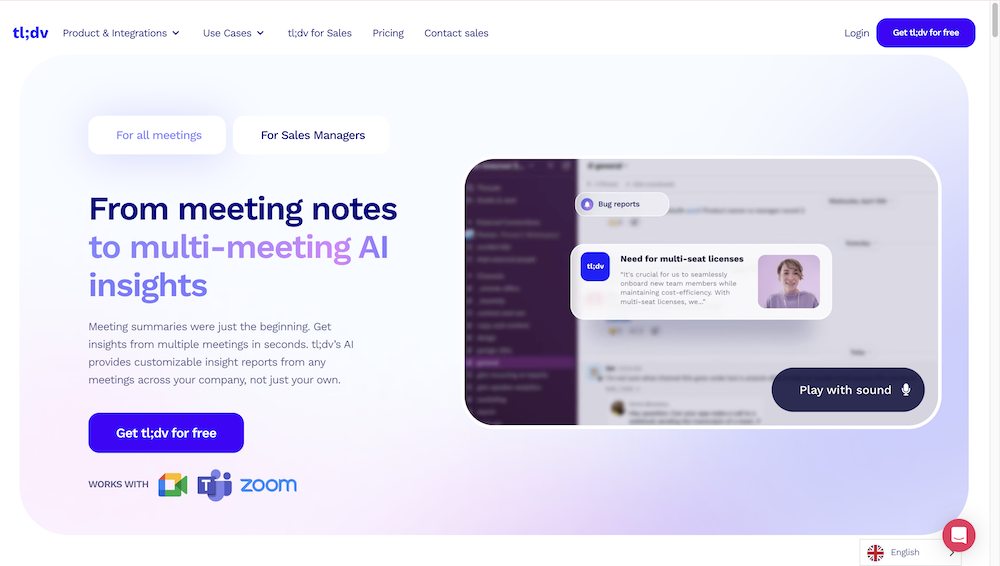Founded in 2020, tl;dv (too long; didn’t view) is an AI meeting assistant designed to make your Zoom and Google Meet calls more efficient by focusing on what really matters: key takeaways. Rather than transcribing everything word-for-word, tl;dv lets you tag important moments during a call, enabling quicker alignment and review across teams.

🔍 Feature Deep-Dive
🎯 Highlight Key Moments
What makes tl;dv stand out is its ability to capture important highlights in real-time. With a single click, you can mark a moment and automatically generate a timestamped reference. These highlights are not only saved but can also be shared with teammates—great for asynchronous teams or stakeholder updates.
🧬 AI Summaries & Speaker Labels
Once your meeting concludes, tl;dv generates an AI-powered summary that outlines decisions, action items, and key discussion points. It also supports speaker identification in over 25 languages, which helps contextualize discussions and improves readability.
🎞️ Video Clipping & Sharing
You don’t have to send the entire recording anymore. tl;dv allows you to clip key insights from a long meeting and create shareable video snippets. These are ideal for follow-up emails, onboarding, or aligning cross-functional teams.
🌐 Platform Support
- ✅ Zoom
- ✅ Google Meet
- ❌ No support (yet) for Microsoft Teams, Webex, or other platforms
🛠️ Workflow Integrations
- Integrates with Slack and Notion for quick sharing
- API support available on Enterprise plan for custom workflows
- Add clips to knowledge bases or CRM notes
📊 Performance & UX
| Dimension | Rating | Notes |
|---|---|---|
| Real-time tagging | ⭐⭐⭐⭐⭐ | Seamless and accurate |
| Summary quality | ⭐⭐⭐⭐ | Informative, though not as structured as enterprise tools |
| Transcription accuracy | ⭐⭐⭐⭐ | Post-call only, ~90-93% accurate |
| Multilingual support | ⭐⭐⭐⭐ | 25+ languages recognized |
| Ease of Use | ⭐⭐⭐⭐⭐ | No learning curve; intuitive UI |
| Download & Export | ⭐⭐ | Limited to paid plans |
🔒 Privacy & Security
tl;dv is GDPR-compliant and provides:
- End-to-end encryption of recordings
- Admin settings to restrict access and configure retention
- Consent notices for meeting participants
📈 Who Should Use tl;dv?
| Ideal User Profile | Why It Fits |
|---|---|
| Startup Teams | Rapid alignment, async recaps |
| Product Managers | Highlight feature feedback in user interviews |
| Sales Teams | Clip objections, insights, or wins |
| Remote Teams | Avoid meeting fatigue, simplify updates |
💬 Pros & Cons
✅ Pros:
- Real-time highlights and post-meeting summary generation
- Great UX with a simple interface
- Language support for global teams
- Easy-to-share video snippets
❌ Cons:
- No real-time transcript (only after meeting ends)
- Lacks broader platform compatibility (no MS Teams/Webex)
- Exporting data is paywalled
💸 Pricing Overview
| Plan | Price | Best For |
|---|---|---|
| Free | $0/month | Individuals and startups |
| Pro | $20/month/user | Growing teams needing export and clip-sharing |
| Enterprise | Custom | Admin tools, advanced integrations |
🧑💻 Final Verdict from a Product & UX Expert
tl;dv may not be the most feature-heavy transcription platform, but it’s brilliantly focused. It respects your time by centering around the essence of the meeting, not the entire conversation. As a product manager, I see it as a modern tool built for lean teams who thrive on agility and clarity. If your goal is to capture what matters, not everything—you’ll love what tl;dv has to offer in 2025.
🔍 Extended Analysis: tl;dv in Practice
🧑💼 Use Case Walkthroughs
1. Sales Enablement
Sales leaders can use tl;dv to:
- Mark customer objections and competitor mentions during calls.
- Generate highlights of successful pitches to train new reps.
- Share clipped customer feedback directly into CRM entries.
2. Product Feedback & UX Research
Product managers benefit from:
- Timestamping user frustrations or feature requests during interviews.
- Embedding specific video quotes into Confluence or Notion pages.
- Summarizing multi-session discovery interviews across stakeholders.
3. Internal Alignment in Remote Teams
Team leads and project managers can:
- Highlight decisions during sprint planning or retrospectives.
- Reduce Zoom fatigue with async summaries instead of full recordings.
- Improve documentation by exporting annotated transcripts into shared drives.
🧩 Real-World Workflow Comparison
| Tool | Real-Time Transcript | Highlight Feature | AI Summary | Video Clip Export | Zoom Native App | Free Plan |
|---|---|---|---|---|---|---|
| tl;dv | ❌ (post-meeting only) | ✅ | ✅ | ✅ | ✅ | ✅ |
| Fireflies.ai | ✅ | ❌ | ✅ | ❌ | ❌ | ✅ (limited) |
| Votars | ✅ | ✅ | ✅ (structured) | ✅ | ❌ | ✅ (trial) |
| Fathom | ✅ | ✅ | ✅ | ✅ | ✅ | ✅ |
| Otter.ai | ✅ | ✅ | ✅ | ❌ | ❌ | ✅ |
Insight: tl;dv excels in post-meeting reflection and async collaboration, but falls short on real-time transcription needs.
📐 UX Observations from a Product Designer’s Lens
-
Interaction Design:
The highlight function is intuitive—just one click during the call. The UI emphasizes minimal distraction, which supports deep meeting engagement. -
Onboarding Experience:
Super fast: Just sign in with your Google account and start. However, accessing advanced features (like exporting or syncing) requires hunting through menus, which could use simplification. -
Information Architecture:
Timeline-based replay with visible highlights makes context retrieval fast. That said, the lack of live captioning may hinder accessibility during the call itself. -
Delightful Touches:
The ability to create and share 30-second highlight reels via link or Slack is a standout for async-first organizations.
🛠️ Customization & Control
- Custom Labels: You can tag highlights with themes (e.g., #feature-request, #pricing-pushback), helping you search patterns across calls.
- Retention Policies: Enterprise users can define transcript retention and access controls per team.
- Speaker Tag Editing: Post-meeting, users can manually adjust misattributed speaker segments—essential for accuracy in multi-speaker contexts.
📌 What Could Be Improved
- Live Accessibility: No real-time transcript means hearing-impaired users can’t fully benefit during live calls.
- Cross-platform Support: Lacks Microsoft Teams and Webex compatibility, which excludes many enterprise users.
- Pricing Transparency: While the free plan is generous, the Pro features (like exporting) could be unbundled more flexibly.
📢 Final Expert Opinion
tl;dv isn’t trying to be everything—it’s trying to be efficient. For async-first teams, remote product orgs, and growth-stage SaaS companies, it hits the sweet spot: just enough structure, just enough automation, with minimal friction. It’s not for regulated enterprises or courtroom-style transcription—but for capturing what matters most, it’s one of the most focused tools I’ve used.


